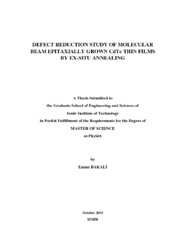Please use this identifier to cite or link to this item:
https://hdl.handle.net/11147/4583| Title: | Defect Reduction Study of Molecular Beam Epitaxially Grown Cdte Thin Flims by Ex-Situ Annealing | Other Titles: | Moleküler Demet Epitaksiye Büyütülen Cdte İnce Filmlerin Tavlama ile Kusur Azaltma Çalışması | Authors: | Bakali, Emine | Advisors: | Selamet, Yusuf | Keywords: | Infrared Detectors Thin films Annealing Scanning Electron Microscope Atomic Force Microscope Raman spectroscopy |
Publisher: | Izmir Institute of Technology | Source: | Bakali, E. (2015). Defect reduction study of molecular beam epitaxially grown CdTe thin flims by ex-situ annealing. Unpublished master's thesis, İzmir Institute of Technology, İzmir, Turkey | Abstract: | Molecular Beam Epitaxy (MBE) grown CdTe thin films were annealed in this study to decrease the number density of defects. For annealing, a system was designed and constructed. During anneals; anneal temperature, anneal time, anneal cycle and hydrogen gas effects were analyzed. The effects of annealing parameters were analyzed by Scanning Electron Microscope (SEM), Atomic Force Microscope (AFM), Everson Etch method, resonance Raman spectroscopy and Photoluminescence measurement. In our studies, dislocation density decreased for 5 min. annealing when annealing temperature increased. Dislocation density decreased with increasing annealing time. Besides, dislocation density decreased when cycle number increased. Te precipitation decreased with annealing. Raman mode at 144 cm-1 was investigated and that mode was decided as Te E mode. Also I2LO/ILO ratio decreased with increasing annealing temperature and annealing time. I2LO/ILO ratio were approached to 1 at 80oK due to so called ‘resonance Raman scattering’. Extra peaks were also observed by Raman scattering. On the surface, small pits occurred when annealing temperature increased. Surface roughness decreased with increasing cycle number. Büyütme sırasında oluşan kusurları azaltmak için, Moleküler Demet Epitaksi (MBE) ile büyütülen CdTe ince filmler tavlandı. Tavlama için bir sistem tasarlandı. Tavlamalar sırasında; tavlama sıcaklığı, tavlama süresi, tavlama devri ve hidrojen gazı etkileri incelendi. Tavlama parammetreleri etkileri Taramalı Uç Mikroskobu (SEM), Atomik Kuvvet Mikroskobu (AFM), Everson eç metodu, resonans Raman Spektroskopisi ve fotoluminesans ölçümleri ile incelendi. Araştırmalar sonucunda 5 dakika boyunca tavlanan örneklerde dislokasyon yoğunluğu tavlama sıcaklığı artarken düşmüştür. Dislokasyon yoğunluğu tavlama süresi arkarken düşmüştür. Ayrıca tavlama devri artarken dislokasyon yoğunluğu düşmüştür. Te çökeltisi tavlamalar sonuda azalmıştır. 144 cm-1 deki raman modu Te E moduna ait olduğu kararlaştırılmıştır. I2LO/ILO oranı tavlama sıcaklığı ve tavlama süresi artarken düşmüştür ve rezonans Raman saçılmasında I2LO/ILO oranı 80oK de 1’e yaklaşmıştır. Raman saçılmalarında yeni pikler gözlemlenmiştir. Sıcaklık artarken örnek yüzeyinde küçük çukurlar oluşmuştur. Yüzey pürüzlülüğü tavlama devri artığında düşmüştür. |
Description: | Thesis (Master)--Izmir Institute of Technology, Physics, Izmir, 2015 Full text release delayed at author's request until 2018.11.16 Includes bibliographical references (leaves: 75-77) Text in English; Abstract: Turkish and English xiv, 83 leaves |
URI: | http://hdl.handle.net/11147/4583 |
| Appears in Collections: | Master Degree / Yüksek Lisans Tezleri |
Files in This Item:
| File | Description | Size | Format | |
|---|---|---|---|---|
| T001446.pdf | MasterThesis | 13.64 MB | Adobe PDF |  View/Open |
CORE Recommender
Page view(s)
296
checked on Mar 31, 2025
Download(s)
112
checked on Mar 31, 2025
Google ScholarTM
Check
Items in GCRIS Repository are protected by copyright, with all rights reserved, unless otherwise indicated.